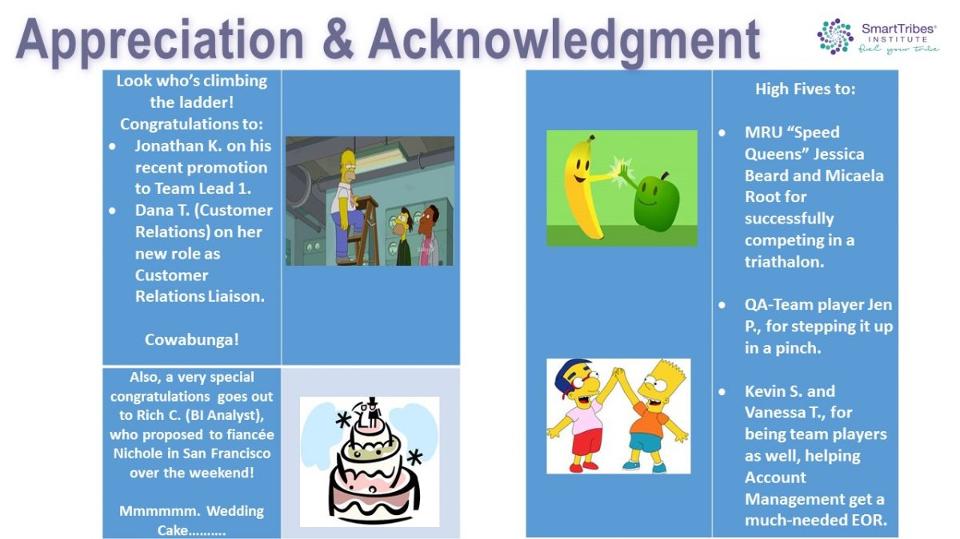
*As originally seen on Forbes.com
Friday, March 3, 2017 was Employee Appreciation Day.
Sure, it’s a day for companies and leaders to thank their employees for their hard work and effort throughout the year. But while having cake and an office party are always fun, shouldn’t employees feel and experience appreciation all year long?
Here are five epic ways to ensure your employees feel appreciated and are in their Smart State year round.

1. Help Them Grow Via Performance Motivation + High Fives And Feedback
Engaged, empowered and appreciated employees will bring their A game every single day. Here are three powerful and proven ways to ensure this result:
• Performance Motivation: use tools to create an environment of internal and external motivation. Performance motivation allows team members to understand their role, believe they are making a difference in their company. They will experience safety, belonging and mattering.
• Appreciation Celebration: Celebrating successes on a regular basis through visible appreciation (high five emails to the team, weekly round-up emails listing individual employee’s wins, leaderboards showing employees who are achieving their needle movers, gamification that shows who has won what based on their specific goals).
• Feedback: Creating an environment where employees feel safe to offer feedback and to receive feedback on an ongoing basis.
How are you creating a culture where your employees are motivated to grow both externally and internally?
2. Help Them Feel Powerful Via Emotional Resilience
To create an environment where team members feel powerful, effective, enrolled and engaged requires leaders to manage their emotional state and show others how to too. Remember when I talked about how you can choose your meaning in any given situation? No matter what happens outside of us, we always get to choose the meaning we make about it inside.
Emotional resilience is the ability to deal with the toughest, most challenging situations. It’s being able to bounce back even when you fail big. Emotional resilience is the one thing that will ensure you navigate through situations where others would give up. To briefly recap from my previous blog on EQ, there are four steps:
1. Figure out what you’re feeling
2. Take a breather
3. Consider the recipient
4. Focus on the outcome
When we create an environment where employees create behavior patterns that come from emotional empowerment and choice, rather than from compulsive reaction, we are helping them feel good about who they are. This is achieved through re-structuring the Trigger, Routine, Reward sequence of a behavior. I discuss exactly how this process works in two previous blogs: “How Humans Experience The World” and “Get Behavior Change That Lasts Using Neuroscience.”
How are you helping your employees to feel powerful?
3. Help Them Have Fun
All of our clients either have or are in the process of launching High 5 programs where any employee can appreciate and acknowledge the contribution of another. These work best when the High 5 is about modeling a company value. Others hold mini-golf tournaments in the middle of the office where each hole celebrates a company goal or value. Others have story time where leaders tell stories of triumphs—both personal and professional—that they have overcome and how. Some clients host annual competitions for which department makes the coolest/weirdest/most amazing gingerbread house, gingerbread haunted house, gingerbread turkey (all are kits from Trader Joe’s!).
There are countless ways to have fun and even attach empowering meaning to it at the same time.
How are you helping your employees have fun?
4. Help Them Have Peace Via Mindfulness Practices
The proven results of mindfulness practices are profound: improved concentration, improved focus and attention, less stress and anxiety, greater productivity, stronger leadership, happier more peaceful and fulfilling lives, more energy, better sleep.
Every highly accomplished leader and employee I know learns to stop the world and to stop their thoughts, on command. This is one of the best ways to make key decisions, to determine if a competitive action is truly a threat, to see future products, to assess the current state of a person who is struggling.
When we share mindfulness techniques with our employees, we are inviting them to embrace inner peace and experience more emotional choice and empowerment. These practices can include:
• Exercise
• Meditation
• Stillness Practices: energy recall, gratitude practice, news feed, light shower, heart opening, brain dump
Are you empowering your employees to embrace inner peace?
5. Help Them Have Trust
Trust is key for employees to be engaged. Lack of trust creates an environment where concerns quickly evolve into fears. And when fears collide with a belief that the system is failing, trouble results. Also as distrust and fear increase, the negative impact on employee morale, engagement and performance accelerate. When we create environments where trust is prevalent, employees will feel like their voice is heard and that they are appreciated.

Shared Identity + Profound Meaning = Tribe = Trust
There are three levels of trust that an employee must feel sustainability:
• Trust in their team: Are there bullies in your organization? Are you letting them thrive?
• Trust in their company: Consider your organization’s capability, commitment, and character. How are you doing?
• Trust in their leader: Trust starts at the top where the culture of the organization is formed–leaders must build a solid foundation where employee trust and engagement can thrive.
What other cool rituals does your culture have?





